Improving the Surface Properties of an API 5L Grade B Pipeline Steel by Applying the Boriding Process—Part II: On the Changes in the Mechanical Properties
Abstract
1. Introduction
- Microhardness of the boride layer: the changes in the boride layer microhardness at different times and temperature conditions are presented and analyzed.
- Ductility, yield strength, and ultimate tensile strength: Because ductility is one of the main characteristics of these pipeline steels, it is important to demonstrate that after the boriding process, this characteristic remains intact. Likewise, yield strength and UTS must not change in value significantly. This is important because these parameters are typically used to estimate the pipeline failure pressure [14,15,16,17].
- Erosion–corrosion: The corrosion resistance of the boride layer on pipeline steel is demonstrated when it is in contact with a solution with oilfield-produced water characteristics [18], and abrasive particles when it is acidified with acetic acid.
- Wear test: The tribological behavior of the API 5L grade B after the boriding process is evaluated using a sand/rubber apparatus.
- Overall discussion: The results obtained in Part I and Part II of the present research are jointly analyzed and discussed.
2. Materials and Methods
2.1. Experimental Background and Specimen Sizes
2.2. Layers Microhardness Estimation
2.3. Tensile Tests
2.4. Corrosion Tests
2.5. Abrasive Wear Tests
3. Results
3.1. Layer Hardness Estimations
3.2. Tensile Tests Results (Ductility, Yield Strength, and UTS)
3.3. Corrosion Test Results
3.4. Abrasive Wear Tests
4. Overall Discussion
4.1. Effects of the Boriding Treatment Condition on Surface and Substrate
4.2. Erosion–Corrosion and Wear Resistance
4.3. Future Works for Industrial Applications
- Changes in the mechanical properties of the pipeline steels because of the thermochemical process.
- Assessment of the corrosion resistance considering the nature of the acidity, because some acids can diminish the protective characteristics of the boride layers.
- The use of electrochemical techniques to assess the corrosion protection in borided API 5L grade B steel. Open-circuit potential to evaluate the tendency to form oxides, electrochemical impedance spectroscopy to study the possible mechanism, and Tafel to determine the instantaneous corrosion rate.
- The analysis of the interaction of the boride layer on pipeline steels and other corrosion mechanisms, especially when the geometry of the pipe fitting is involved.
- A more in-depth study on the interaction and influence of steel microalloys on the boride layers, as well as other pipeline steels from the API 5L series.
5. Conclusions
- Higher temperatures tend to form more stable boride layers with greater hardness. The stability of the boride layers can be observed when the hardness is assessed in the specimen cross-section; it is necessary to move away from the surface to note a drop in hardness.
- Increments in the grain size at higher temperatures of the thermochemical treatment provoke changes in the ductility of pipeline steel. This is important because the main application of API 5L grade steel is to manufacture pipes, which are often under loads that cause deformities.
- When API 5L grade B steel is subjected to powder-pack boriding, this can offer protection against erosion–corrosion mechanisms in oil-field-produced water environments with sand particles, as long as they are not acidified by nitric acid. Boriding of API 5L grade steel offers satisfactory protection if the fluid contains acetic acid. Increasing the treatment temperature in the boriding process does not significantly improve the corrosion resistance of the studied steel.
- Sand/rubber tests confirmed the improvement in wear surface resistance of the borided pipeline steel compared to the nontreated material. However, increasing the treatment temperature did not generate greater wear resistance.
- It seems that the best condition under which to treat API 5L grade B steel with boron is at the lowest possible temperature, because this prevents considerable modification to the substrate’s mechanical characteristics, while offering adequate corrosion and wear resistance.
Author Contributions
Funding
Institutional Review Board Statement
Informed Consent Statement
Data Availability Statement
Acknowledgments
Conflicts of Interest
References
- Liu, H.; Zhou, Z.; Liu, M. A Probability Model of Predicting the Sand Erosion Profile in Elbows for Gas Flow. Wear 2015, 342–343, 377–390. [Google Scholar] [CrossRef]
- Parsi, M.; Najmi, K.; Najafifard, F.; Hassani, S.; McLaury, B.S.; Shirazi, S.A. A Comprehensive Review of Solid Particle Erosion Modeling for Oil and Gas Wells and Pipelines Applications. J. Nat. Gas Sci. Eng. 2014, 21, 850–873. [Google Scholar] [CrossRef]
- Kanesan, D.; Mohyaldinn, M.E.; Ismail, N.I.; Chandran, D.; Liang, C.J. An Experimental Study on the Erosion of Stainless Steel Wire Mesh Sand Screen Using Sand Blasting Technique. J. Nat. Gas Sci. Eng. 2019, 65, 267–274. [Google Scholar] [CrossRef]
- Reda, Y.; Gamal, A.; Abdel-Karim, R.; El-Raghy, S.M. Erosion–Corrosion Behaviour of ASTM A106 GR.B Carbon Steel Pipelines. J. Bio Tribo-Corros 2023, 9, 8. [Google Scholar] [CrossRef]
- Chen, P.; Cui, B.; Li, J.; Zheng, J.; Zhao, Y. Particle Erosion under Multiphase Bubble Flow in Horizontal-Vertical-Upward Elbows. Powder Technol. 2022, 397, 117002. [Google Scholar] [CrossRef]
- Svedeman, S.J.; Arnold, K.E. Criteria for Sizing Multiphase Flowlines for Erosive/Corrosive Service. SPE Prod. Facil. 1994, 9, 74–80. [Google Scholar] [CrossRef]
- Salama, M.M. An Alternative to API 14E Erosional Velocity Limits for Sand Laden Fluids. In Proceedings of the Offshore Technology Conference, Houston, TX, USA, 4–7 May 1998. [Google Scholar] [CrossRef]
- Jordan, K.G. Erosion in Multiphase Production of Oil & Gas. In CORROSION 98; NACE: San Diego, CA, USA, 1998; p. 98058. [Google Scholar]
- Cosham, A.; Hopkins, P. The Effect of Dents in Pipelines—Guidance in the Pipeline Defect Assessment Manual. Int. J. Press. Vessel. Pip. 2004, 81, 127–139. [Google Scholar] [CrossRef]
- Tian, X.; Zhang, H. Failure Pressure of Medium and High Strength Pipelines with Scratched Dent Defects. Eng. Fail. Anal. 2017, 78, 29–40. [Google Scholar] [CrossRef]
- Tian, X.; Zhang, H. Failure Criterion of Buried Pipelines with Dent and Scratch Defects. Eng. Fail. Anal. 2017, 80, 278–289. [Google Scholar] [CrossRef]
- Vishnuvardhan, S.; Murthy, A.R.; Choudhary, A. A Review on Pipeline Failures, Defects in Pipelines and Their Assessment and Fatigue Life Prediction Methods. Int. J. Press. Vessel. Pip. 2023, 201, 104853. [Google Scholar] [CrossRef]
- Alcantar-Martínez, L.M.; Ruiz-Trabolsi, P.; Tadeo-Rosas, R.; Miranda-Hernández, J.; Terán-Méndez, G.; Velázquez, J.C.; Hernández-Sánchez, E. Improving the Surface Properties of an API 5L Grade B Pipeline Steel by Applying the Boriding Process. Part I: Kinetics and Layer Characterization. Coatings 2023, 13, 298. [Google Scholar] [CrossRef]
- Velázquez, J.C.; González-Arévalo, N.E.; Díaz-Cruz, M.; Cervantes-Tobón, A.; Herrera-Hernández, H.; Hernández-Sánchez, E. Failure Pressure Estimation for an Aged and Corroded Oil and Gas Pipeline: A Finite Element Study. J. Nat. Gas Sci. Eng. 2022, 101, 104532. [Google Scholar] [CrossRef]
- González-Arévalo, N.E.; Velázquez, J.C.; Díaz-Cruz, M.; Cervantes-Tobón, A.; Terán, G.; Hernández-Sanchez, E.; Capula-Colindres, S. Influence of Aging Steel on Pipeline Burst Pressure Prediction and Its Impact on Failure Probability Estimation. Eng. Fail. Anal. 2021, 120, 104950. [Google Scholar] [CrossRef]
- Velázquez, J.C.; Caleyo, F.; Hallen, J.M.; Romero-Mercado, O.; Herrera-Hernandez, H. Probabilistic Analysis of Different Methods Used to Compute the Failure Pressure of Corroded Steel Pipelines. Int. J. Electrochem. Sci. 2013, 2013, 11356–11370. [Google Scholar]
- Terán, G.; Capula-Colindres, S.; Velázquez, J.C.; Angeles-Herrera, D.; Torres-Santillán, E. On the Influence of the Corrosion Defect Size in the Welding Bead, Heat-Affected Zone, and Base Metal in Pipeline Failure Pressure Estimation: A Finite Element Analysis Study. J. Press. Vessel. Technol. 2019, 141, 031001-1–031001-8. [Google Scholar] [CrossRef]
- Velázquez, J.C.; Cruz-Ramirez, J.C.; Valor, A.; Venegas, V.; Caleyo, F.; Hallen, J.M. Modeling Localized Corrosion of Pipeline Steels in Oilfield Produced Water Environments. Eng. Fail. Anal. 2017, 79, 216–231. [Google Scholar] [CrossRef]
- ASTM E8/E8M; Standard Test Methods for Tension Testing of Metallic Materials. ASTM Volume 03.01 Metals—Mechanical Testing; Elevated and Low-Temperature Tests. Metallography. ASTM International: West Conshohocken, PA, USA, 2016.
- ASTM G65-00; Standard Test Method for Measuring Abrasion Using the Dry Sand/Rubber Wheel Apparatus. American Society for Testing and Materials. ASTM International: West Conshohocken, PA, USA, 2015.
- ASTM E384; Standard Test Method for Microindentation Hardness of Materials. ASTM International: West Conshohocken, PA, USA, 2013.
- Vable, M. Mechanics of Materials; Oxford University Press: New York, NY, USA, 2008. [Google Scholar]
- Tandon, S.; Gao, M.; McNealy, R. Erosion-Corrosion Failure of A Carbon Steel Pipe Elbow-A Case Study. In CORROSION 2009; NACE: Atlanta, GA, USA, 2009; p. 9479. [Google Scholar]
- Cabrera-Sierra, R. Corrosion Studies of Carbon Steel Immersed in NACE Brine by Weight Loss, EIS and XRD Techniques. Int. J. Electrochem. Sci. 2016, 11, 10185–10198. [Google Scholar] [CrossRef]
- Nešić, S. Key Issues Related to Modelling of Internal Corrosion of Oil and Gas Pipelines—A Review. Corros. Sci. 2007, 49, 4308–4338. [Google Scholar] [CrossRef]
- Zhang, G.A.; Cheng, Y.F. On the Fundamentals of Electrochemical Corrosion of X65 Steel in CO2-Containing Formation Water in the Presence of Acetic Acid in Petroleum Production. Corros. Sci. 2009, 51, 87–94. [Google Scholar] [CrossRef]
- Holmberg, K.; Ronkainen, H.; Matthews, A. Tribology of Thin Coatings. Ceram. Int. 2000, 26, 787–795. [Google Scholar] [CrossRef]
- von Matuschka, M.G. Boronizing, 1st ed.; Carl Hanser: Munich, Germany, 1980. [Google Scholar]
- Hernández-Sánchez, E.; Velázquez, J.C. Kinetics of Growth of Iron Boride Layers on a Low-Carbon Steel Surface. In Laboratory Unit Operations and Experimental Methods in Chemical Engineering; InTech: Vienna, Austria, 2018. [Google Scholar] [CrossRef]
- Chino-Ulloa, A.; Ruiz-Trabolsi, P.A.; Torres-Avila, I.P.; Orozco-Álvarez, C.; Tadeo-Rosas, R.; Velázquez, J.C.; Hernández-Sánchez, E. Kinetics and Mechanical Characterization of Hard Layers Obtained by Boron Diffusion in 80/20 Nickel–Chromium Alloy. Coatings 2022, 12, 1387. [Google Scholar] [CrossRef]
- Minitab 20 Support. Interpret the Key Results for Interval Plot. Available online: https://support.minitab.com/en-us/minitab/20/help-and-how-to/graphs/interval-plot/interpret-the-results/key-results/ (accessed on 10 December 2022).
- Velázquez-Altamirano, J.C.; Torres-Avila, I.P.; Teran-Méndez, G.; Capula-Colindres, S.I.; Cabrera-Sierra, R.; Carrera-Espinoza, R.; Hernández-Sánchez, E. A Stochastic Model and Investigation into the Probability Distribution of the Thickness of Boride Layers Formed on Low-Carbon Steel. Coatings 2019, 9, 756. [Google Scholar] [CrossRef]
- Ruiz-Trabolsi, P.A.; Velázquez, J.C.; Orozco-Álvarez, C.; Carrera-Espinoza, R.; Yescas-Hernández, J.A.; González-Arévalo, N.E.; Hernández-Sánchez, E. Kinetics of the Boride Layers Obtained on AISI 1018 Steel by Considering the Amount of Matter Involved. Coatings 2021, 11, 259. [Google Scholar] [CrossRef]
- ADMET Material Testing System Manufacturer. Materials Testing Glossary. Available online: https://www.admet.com/materials-testing-glossary/#:~:text=Elongation%20is%20defined%20as%20the,the%20original%20cross%20sectional%20area (accessed on 12 December 2022).
- Vargas-Arista, B.; Hallen, J.M.; Albiter, A. Effect of Artificial Aging on the Microstructure of Weldment on API 5L X-52 Steel Pipe. Mater. Charact. 2007, 58, 721–729. [Google Scholar] [CrossRef]
- Günen, A.; Kurt, B.; Somunkιran, İ.; Kanca, E.; Orhan, N. The Effect of Process Conditions in Heat-Assisted Boronizing Treatment on the Tensile and Bending Strength Characteristics of the AISI-304 Austenitic Stainless Steel. Phys. Met. Metallogr. 2015, 116, 896–907. [Google Scholar] [CrossRef]
- Calik, A.; Sahin, O.; Ucar, N. Mechanical Properties of Boronized AISI 316, AISI 1040, AISI 1045 and AISI 4140 Steels. Acta Phys. Pol. A 2009, 115, 694–698. [Google Scholar] [CrossRef]
- American Petroleum Institute. API 5L Specifications for Line Pipe; American Petroleum Institute, API: Houston, TX, USA, 2007. [Google Scholar]
- Caleyo, F.; Valor, A.; Venegas, V.; Espina-Hernandez, J.H.; Velázquez, J.C.; Hallen, J.M. Accurate Corrosion Modeling Improves Reliability Estimations. Oil Gas J. 2012, 110, 122–129. [Google Scholar]
- Campos-Silva, I.E.; Rodríguez-Castro, G.A. Boriding to Improve the Mechanical Properties and Corrosion Resistance of Steels. In Thermochemical Surface Engineering of Steels; Elsevier: Amsterdam, The Netherlands, 2015; pp. 651–702. [Google Scholar] [CrossRef]
- Günen, A.; Kanca, Y.; Karahan, İ.H.; Karakaş, M.S.; Gök, M.S.; Kanca, E.; Çürük, A. A Comparative Study on the Effects of Different Thermochemical Coating Techniques on Corrosion Resistance of STKM-13A Steel. Metall. Mater. Trans. A 2018, 49, 5833–5847. [Google Scholar] [CrossRef]
- Sliman, G.; SAMI, Z.; Abdelkader, R.; Tassi, H. Comparative Study on Electrochemical Corrosion Behavior of Boronized X52 Steel in 1 M HCl and H2SO4 Solutions. Metall. Mater. Eng. 2022, 28, 531–538. [Google Scholar] [CrossRef]
- Hocine, T.; Sami, Z.; Omar, A. Effect of Martensite Morphologies on Corrosion in 5% H2SO4 Solution of Borided X70 Dual Phase Steel. Ann. Chim. Sci. Matér. 2021, 45, 69–74. [Google Scholar] [CrossRef]
- Erdemir, A.; Bindal, C.; Zuiker, C.; Savrun, E. Tribology of Naturally Occurring Boric Acid Films on Boron Carbide. Surf. Coat. Technol. 1996, 86–87, 507–510. [Google Scholar] [CrossRef]
- Hernández-Sanchez, E.; Chino-Ulloa, A.; Velazquez, J.C.; Herrera-Hernández, H.; Velázquez-Mancilla, R.; Carrera-Espinoza, R. Effect of Relative Humidity on the Tribological Properties of Self-Lubricating H3BO3 Films Formed on the Surface of Steel Suitable for Biomedical Applications. Adv. Mater. Sci. Eng. 2015, 2015, 436597. [Google Scholar] [CrossRef]
- Ruiz-Trabolsi, P.A.; Chino-Ulloa, A.; Miranda-Hernández, J.G.; Tadeo-Rosas, R.; Carrera-Espinoza, R.; Velázquez, J.C.; Hernández-Sánchez, E. A Comparative Analysis of the Tribological Behavior of Hard Layers Obtained by Three Different Hardened-Surface Processes on the Surface of AISI 4140 Steel. Crystals 2022, 12, 298. [Google Scholar] [CrossRef]
- Hernández-Sánchez, E.; Velázquez, J.C.; Castrejón-Flores, J.L.; Chino-Ulloa, A.; Avila, I.P.T.; Carrera-Espinoza, R.; Yescas-Hernández, J.A.; Orozco-Alvarez, C. Tribological Behavior of Borided AISI 316L Steel with Reduced Friction Coefficient and Enhanced Wear Resistance. Mater. Trans. 2019, 60, 156–164. [Google Scholar] [CrossRef]
- Rodríguez-Castro, G.; Campos-Silva, I.; Chávez-Gutiérrez, E.; Martínez-Trinidad, J.; Hernández-Sánchez, E.; Torres-Hernández, A. Mechanical Properties of FeB and Fe2B Layers Estimated by Berkovich Nanoindentation on Tool Borided Steel. Surf. Coat. Technol. 2013, 215, 291–299. [Google Scholar] [CrossRef]
- Meléndez, E.; Campos, I.; Rocha, E.; Barrón, M.A. Structural and Strength Characterization of Steels Subjected to Bonding Thermochemical Process. Mater. Sci. Eng. A 1997, 234–236, 900–903. [Google Scholar] [CrossRef]
- Campos-Silva, I.; Ortiz-Domínguez, M.; Keddam, M.; López-Perrusquia, N.; Carmona-Vargas, A.; Elías-Espinosa, M. Kinetics of the Formation of Fe2B Layers in Gray Cast Iron: Effects of Boron Concentration and Boride Incubation Time. Appl. Surf. Sci. 2009, 255, 9290–9295. [Google Scholar] [CrossRef]
- Carrera-Espinoza, R.; Figueroa-López, U.; Martínez-Trinidad, J.; Campos-Silva, I.; Hernández-Sánchez, E.; Motallebzadeh, A. Tribological Behavior of Borided AISI 1018 Steel under Linear Reciprocating Sliding Conditions. Wear 2016, 362–363, 1–7. [Google Scholar] [CrossRef]
- Campos-Silva, I.; Hernández-Sánchez, E.; Rodríguez-Castro, G.; Cimenoglu, H.; Nava-Sánchez, J.L.; Meneses-Amador, A.; Carrera-Espinoza, R. A Study of Indentation for Mechanical Characterization of the Fe2B Layer. Surf. Coat. Technol. 2013, 232, 173–181. [Google Scholar] [CrossRef]
- Jiang, J.; Wang, Y.; Zhong, Q.; Zhou, Q.; Zhang, L. Preparation of Fe2B Boride Coating on Low-Carbon Steel Surfaces and Its Evaluation of Hardness and Corrosion Resistance. Surf. Coat. Technol. 2011, 206, 473–478. [Google Scholar] [CrossRef]
- Velázquez, J.C.; Hernández-Sánchez, E.; Terán, G.; Capula-Colindres, S.; Diaz-Cruz, M.; Cervantes-Tobón, A. Probabilistic and Statistical Techniques to Study the Impact of Localized Corrosion Defects in Oil and Gas Pipelines: A Review. Metals 2022, 12, 576. [Google Scholar] [CrossRef]
- Kumaravel, D.; Arunkumar, K. Improve the Wear Property of En19 Steel by Boronizing Process. In Advances in Manufacturing Processes; Springer: Singapore, 2019; pp. 123–131. [Google Scholar] [CrossRef]
- Medvedovski, E.; Antonov, M. Erosion Studies of the Iron Boride Coatings for Protection of Tubing Components in Oil Production, Mineral Processing and Engineering Applications. Wear 2020, 452–453, 203277. [Google Scholar] [CrossRef]


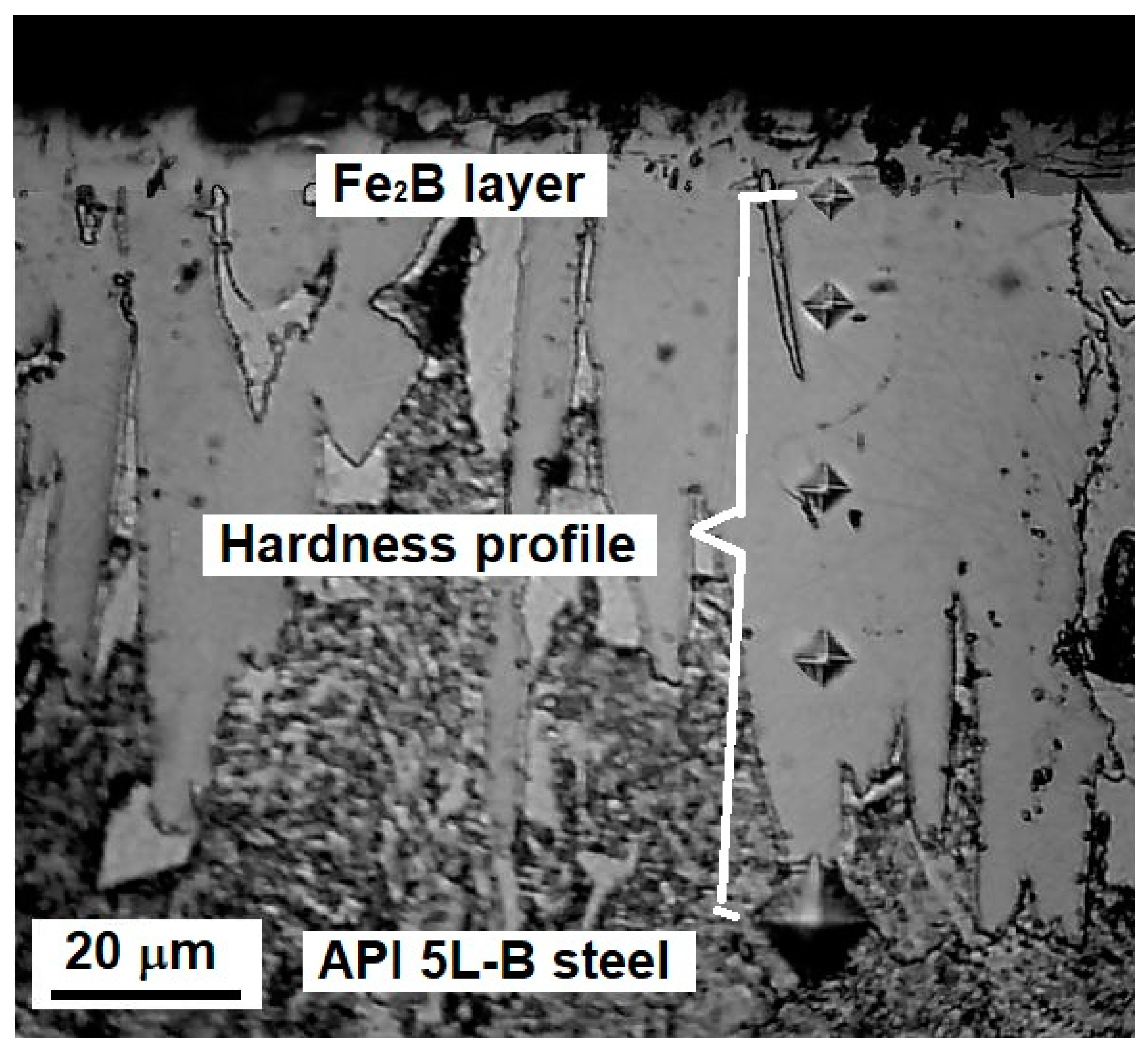
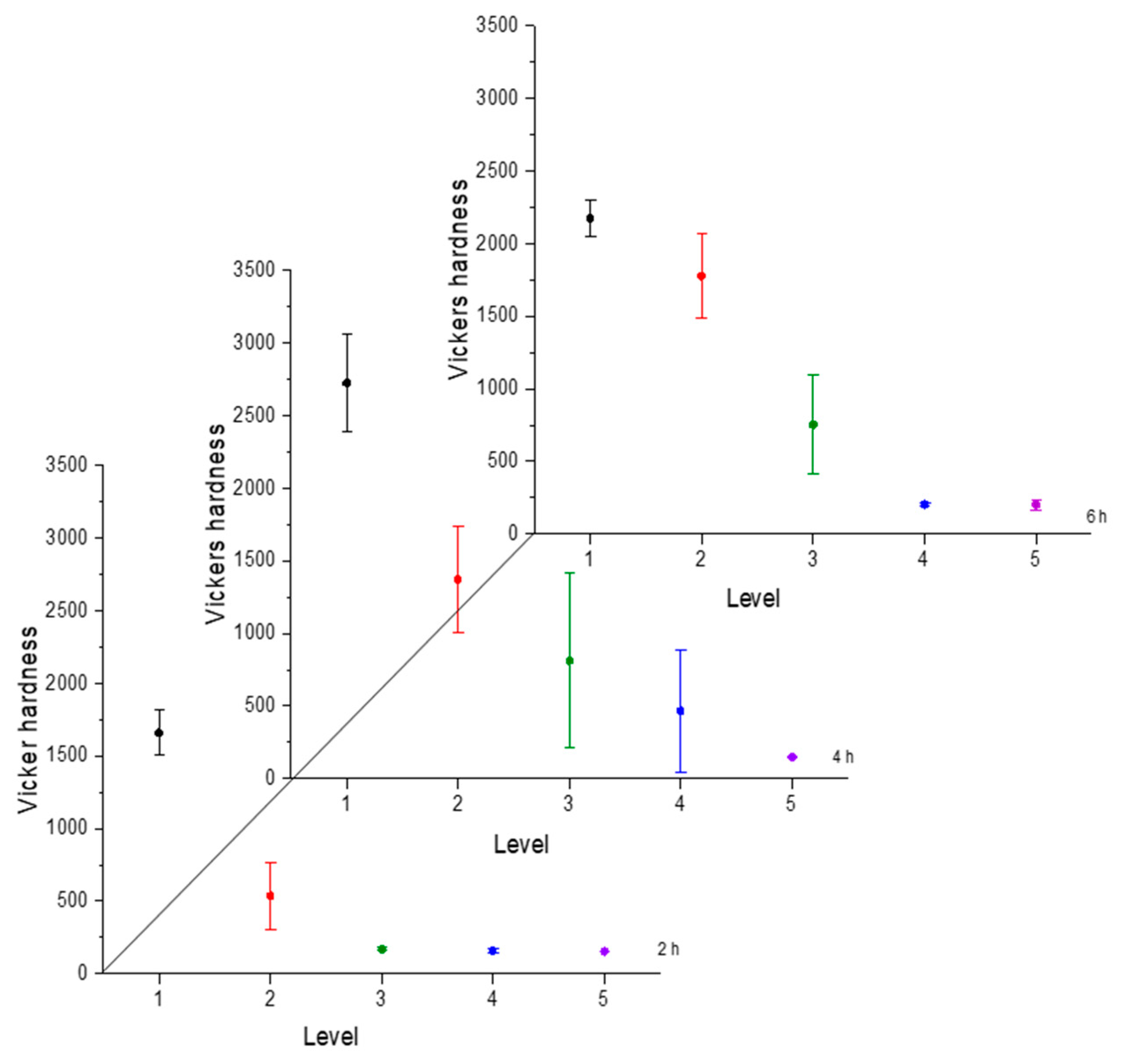
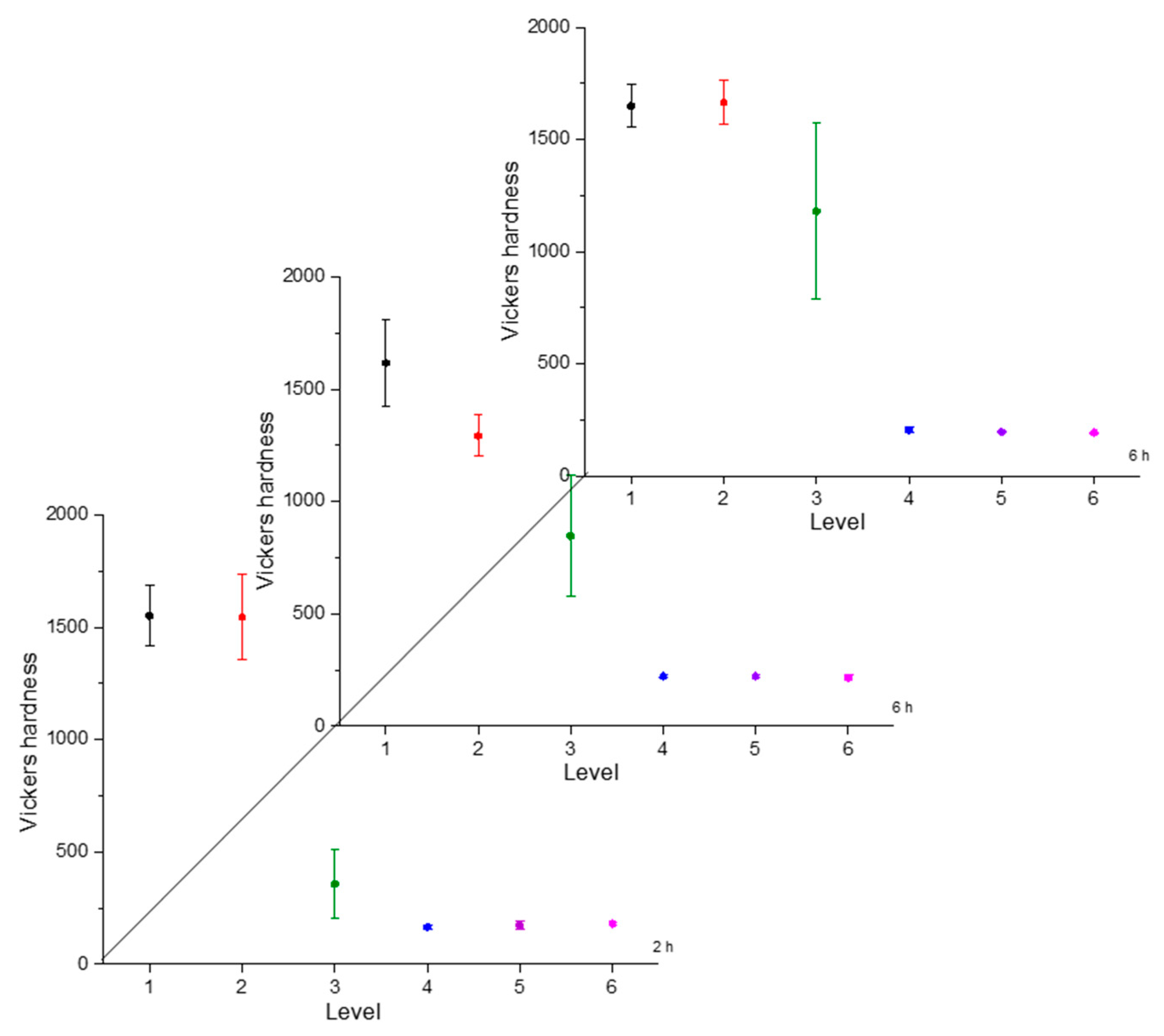


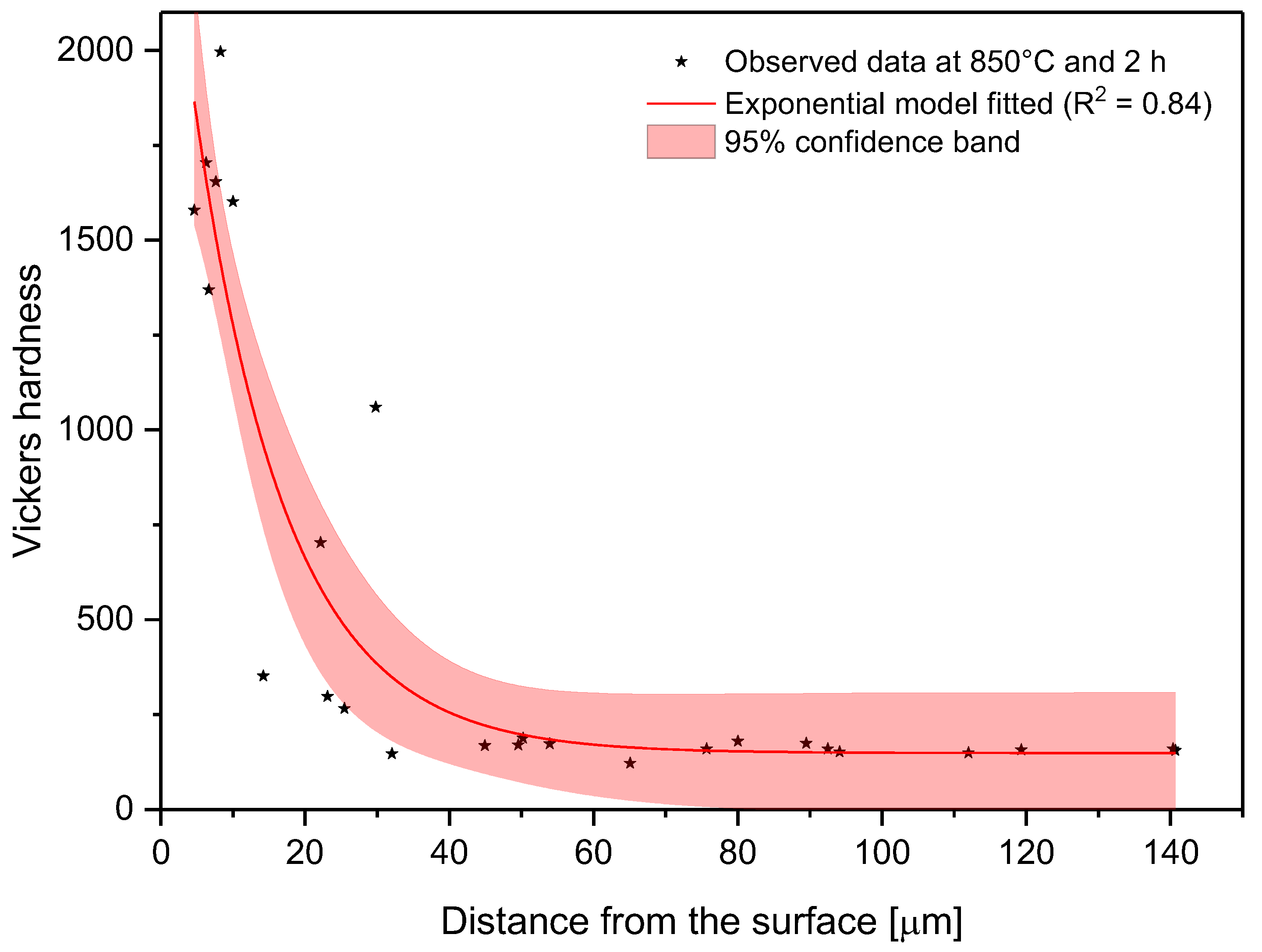
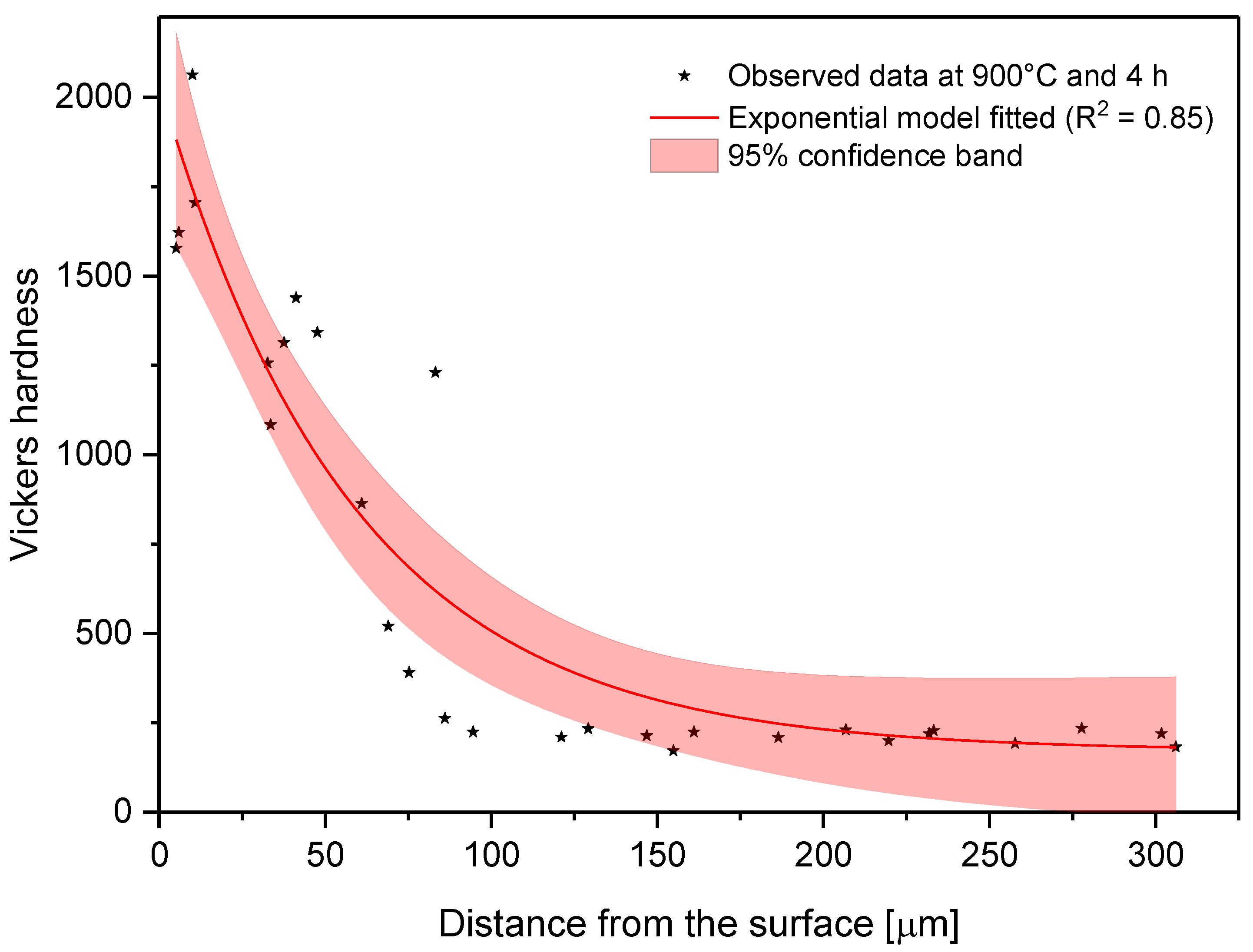
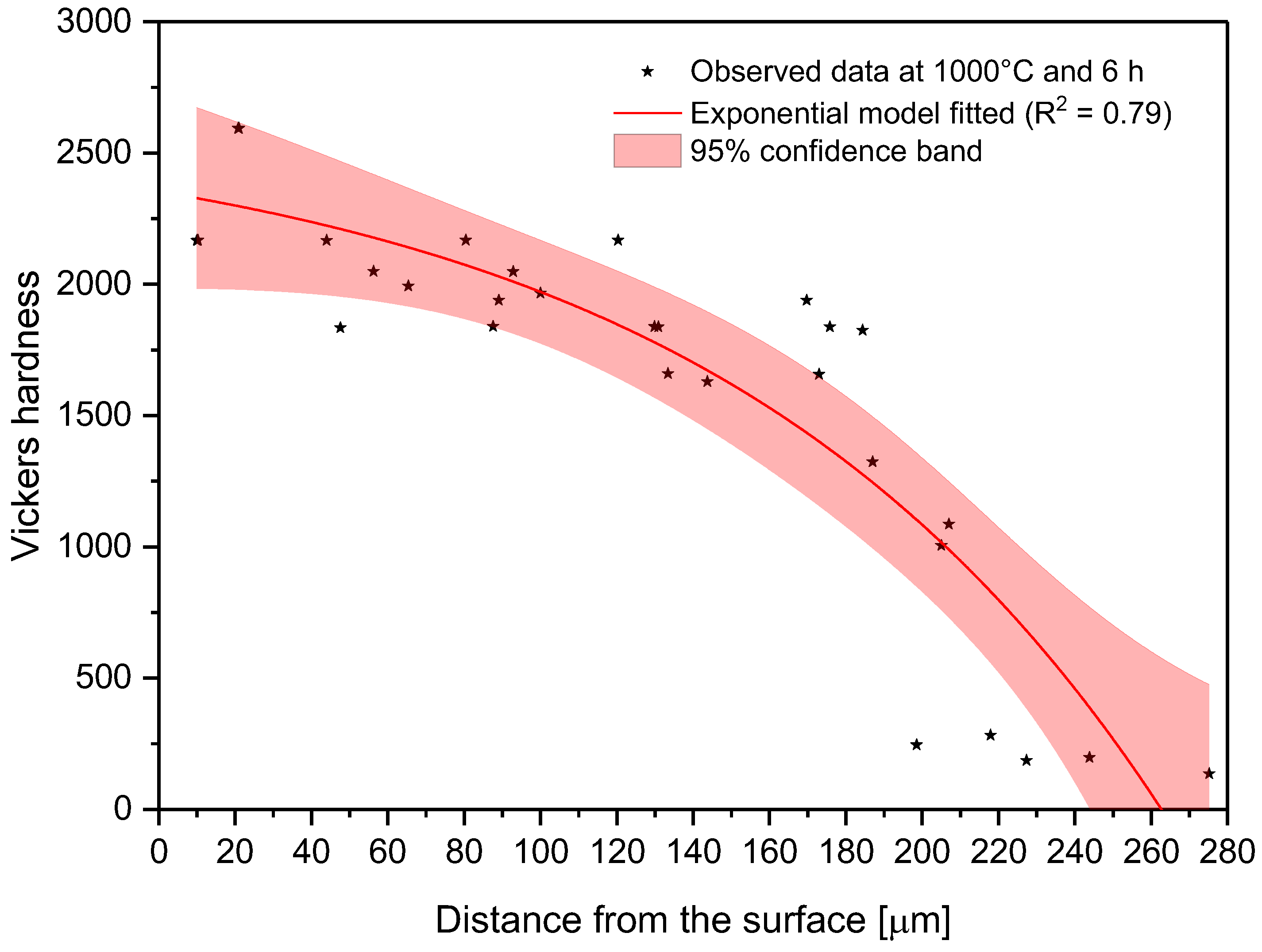
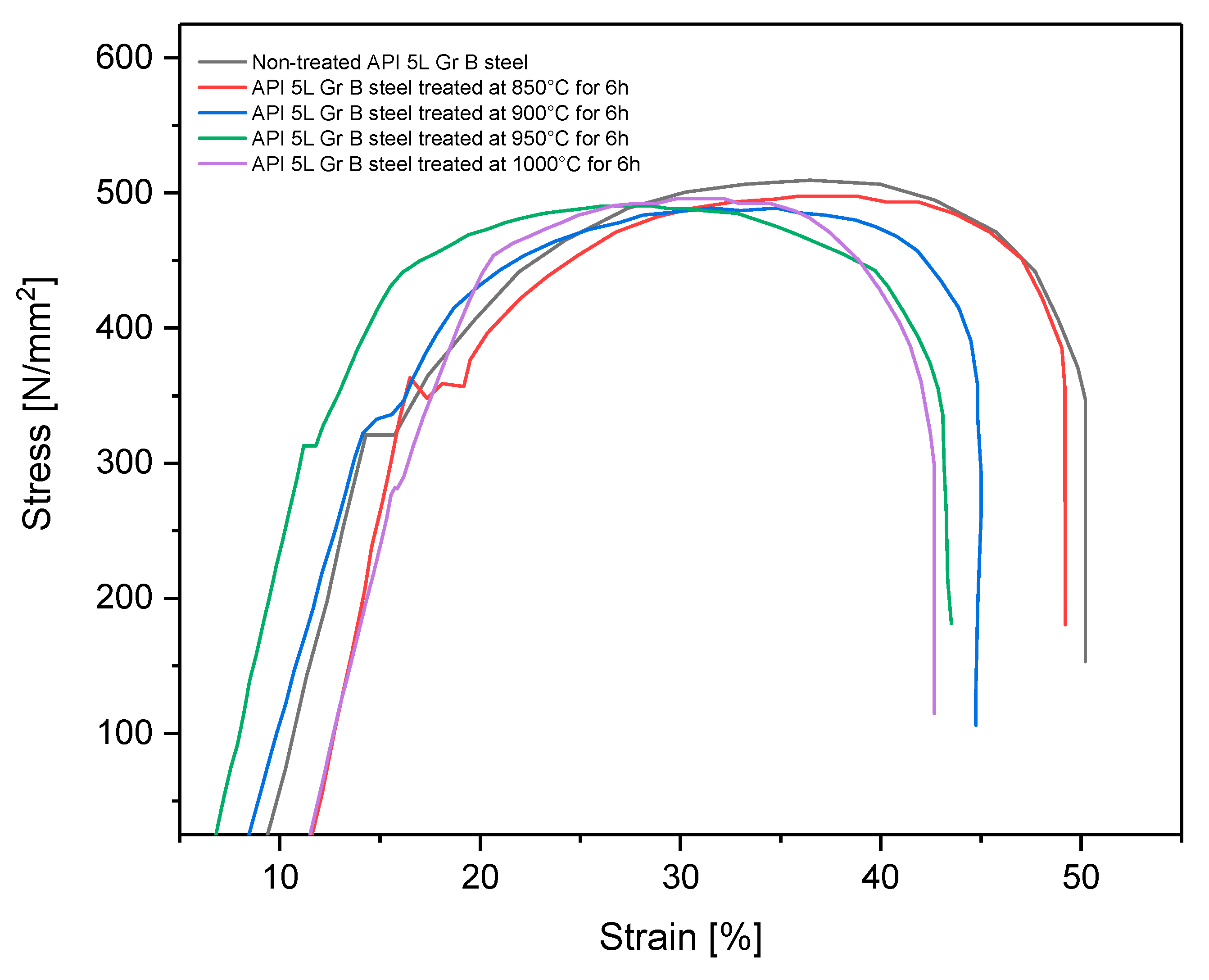

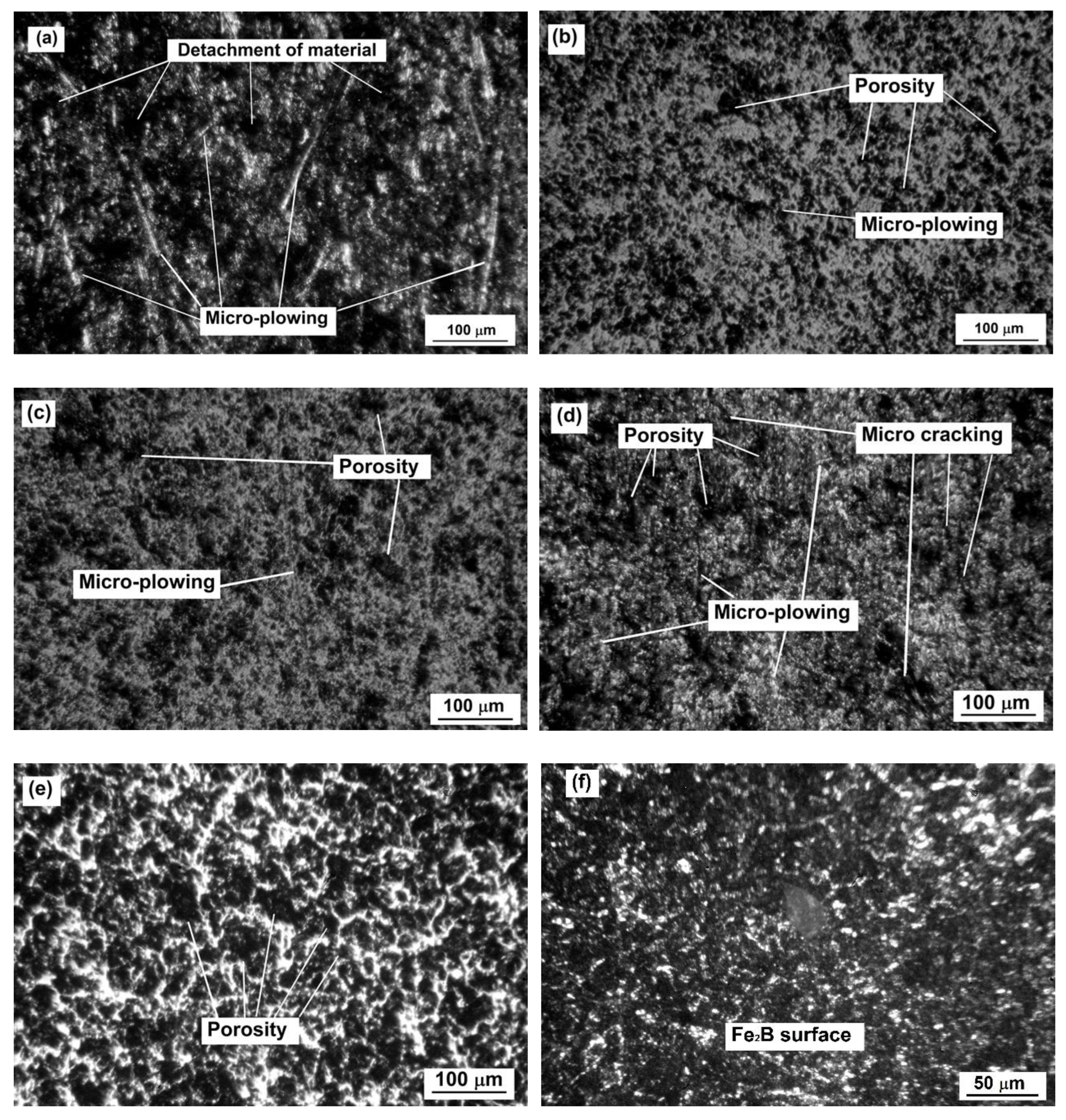
| Sample Number | Treatment Conditions | |
|---|---|---|
| Time (h) | Temperature (°C) | |
| 0 | Nontreated sample | |
| 1 | 2 | - |
| 2 | 4 | 850 |
| 3 | 6 | - |
| 4 | 2 | - |
| 5 | 4 | 900 |
| 6 | 6 | - |
| 7 | 2 | - |
| 8 | 4 | 950 |
| 9 | 6 | - |
| 10 | 2 | - |
| 11 | 4 | 1000 |
| 12 | 6 | - |
| Test Type (ASTM-G65) | Load (N) | Speed (rpm) | Sliding Distance (m) | Time (s) | Sand Flow (g/min) |
|---|---|---|---|---|---|
| C | 130 | 100 | 71.8 | 30 | 300–400 |
| Material | Density (g cm−3) |
|---|---|
| Fe2B | 7.43 [29] |
| API 5L grade B steel | 7.86 [24] |
| Condition | Parameter | Coefficient of Determination (R2) | ||
|---|---|---|---|---|
| 1 | 148.58 | 2469.05 | −0.078 | 0.85 |
| 2 | 150.5 | 3181.51 | −0.039 | 0.77 |
| 3 | 163.36 | 2756.01 | −0.019 | 0.81 |
| 4 | 147.85 | 1888.20 | −0.025 | 0.81 |
| 5 | 171.57 | 1867.02 | −0.017 | 0.85 |
| 6 | 187.80 | 1817.6 | −0.011 | 0.76 |
| 7 | 176.99 | 1981.44 | −0.016 | 0.83 |
| 8 | 197.31 | 2422.18 | −0.011 | 0.73 |
| 9 | 199.98 | 2321.76 | −9.18 × 10−3 | 0.60 |
| 10 | 193.9 | 2110.95 | −0.011 | 0.73 |
| 11 | 194.25 | 1869.04 | 4.25 × 10−3 | 0.51 |
| 12 | 2642.43 | −289.21 | 8.42 × 10−3 | 0.74 |
| Condition of Specimen (Table 1) | Yield Strength (MPa) | Ultimate Tensile Strength (MPa) | Reduction of Area (%) | Elongation (%) |
|---|---|---|---|---|
| 0 | 321.27 | 511.32 | 68.84 | 31.86 |
| 3 | 363.91 | 500.22 | 58.93 | 28.93 |
| 6 | 332.19 | 488.92 | 47.66 | 24.53 |
| 9 | 312.83 | 493.57 | 46.42 | 23.41 |
| 12 | 282.04 | 497.56 | 45.69 | 22.63 |
| Chemical Solution Characteristics | Variable | Nontreated Specimen | Specimen Treated at: | |||
|---|---|---|---|---|---|---|
| 850 °C and 6 h | 900 °C and 6 h | 950 °C and 6 h | 1000 °C and 6 h | |||
| 9952 ppm Cl− and 9992 ppm SO42− adjusted with HNO3 to pH = 3.29 | Total Weight loss (mg) | 18.1 | 36.9 | 23.7 | 15.9 | 27.6 |
| Corrosion rate (mpy) | 109.7 | 222.3 | 141.2 | 92.2 | 159.3 | |
| 9952 ppm Cl− and 9992 ppm SO42− adjusted with CH3COOH to pH = 3.11 | Total Weight loss (mg) | 53.2 | 48.9 | 47.1 | 48.3 | 42.9 |
| Corrosion rate (mpy) | 331.1 | 302.8 | 300.1 | 297.7 | 260.2 | |
| Treatment Condition | Initial Mass | Final Mass | Mass Loss | Loss of Volume | Wear Rate |
|---|---|---|---|---|---|
| (See Table 1) | (g) | (g) | (g) | (mm−3) | (mm3 N−1 m−1) |
| 0 | 140.5529 ± 0.0767 | 140.4752 ±0.0773 | 0.0777 ± 0.0025 | 9.8981 ± 0.3182 | 1.07 × 10−3 |
| 3 | 140.5777 ± 0.0015 | 140.5766 ± 0.0006 | 0.0011 ± 0.0010 | 0.1401 ± 0.1215 | 1.52 × 10−5 |
| 6 | 140.2192 ± 0.0022 | 140.2174 ± 0.0010 | 0.0018 ± 0.0012 | 0.2293 ± 0.1550 | 1.68 × 10−5 |
| 9 | 141.0599 ± 0.0080 | 141.0510 ± 0.0087 | 0.0090 ± 0.0026 | 1.1423 ± 0.3254 | 1.24 × 10−4 |
| 12 | 141.0961 ± 0.0116 | 141.0854 ± 0.0078 | 0.0107 ± 0.0054 | 1.3588 ± 0.6898 | 1.47 × 10−4 |
Disclaimer/Publisher’s Note: The statements, opinions and data contained in all publications are solely those of the individual author(s) and contributor(s) and not of MDPI and/or the editor(s). MDPI and/or the editor(s) disclaim responsibility for any injury to people or property resulting from any ideas, methods, instructions or products referred to in the content. |
© 2023 by the authors. Licensee MDPI, Basel, Switzerland. This article is an open access article distributed under the terms and conditions of the Creative Commons Attribution (CC BY) license (https://creativecommons.org/licenses/by/4.0/).
Share and Cite
Alcantar-Martínez, L.M.; Ruiz-Trabolsi, P.A.; Tadeo-Rosas, R.; Miranda-Hernández, J.G.; Cabrera-Sierra, R.; Velázquez, J.C.; Hernández-Sánchez, E. Improving the Surface Properties of an API 5L Grade B Pipeline Steel by Applying the Boriding Process—Part II: On the Changes in the Mechanical Properties. Coatings 2023, 13, 470. https://doi.org/10.3390/coatings13020470
Alcantar-Martínez LM, Ruiz-Trabolsi PA, Tadeo-Rosas R, Miranda-Hernández JG, Cabrera-Sierra R, Velázquez JC, Hernández-Sánchez E. Improving the Surface Properties of an API 5L Grade B Pipeline Steel by Applying the Boriding Process—Part II: On the Changes in the Mechanical Properties. Coatings. 2023; 13(2):470. https://doi.org/10.3390/coatings13020470
Chicago/Turabian StyleAlcantar-Martínez, Laura Montserrat, Pablo Alfredo Ruiz-Trabolsi, Raúl Tadeo-Rosas, José Guadalupe Miranda-Hernández, Román Cabrera-Sierra, Julio César Velázquez, and Enrique Hernández-Sánchez. 2023. "Improving the Surface Properties of an API 5L Grade B Pipeline Steel by Applying the Boriding Process—Part II: On the Changes in the Mechanical Properties" Coatings 13, no. 2: 470. https://doi.org/10.3390/coatings13020470
APA StyleAlcantar-Martínez, L. M., Ruiz-Trabolsi, P. A., Tadeo-Rosas, R., Miranda-Hernández, J. G., Cabrera-Sierra, R., Velázquez, J. C., & Hernández-Sánchez, E. (2023). Improving the Surface Properties of an API 5L Grade B Pipeline Steel by Applying the Boriding Process—Part II: On the Changes in the Mechanical Properties. Coatings, 13(2), 470. https://doi.org/10.3390/coatings13020470






